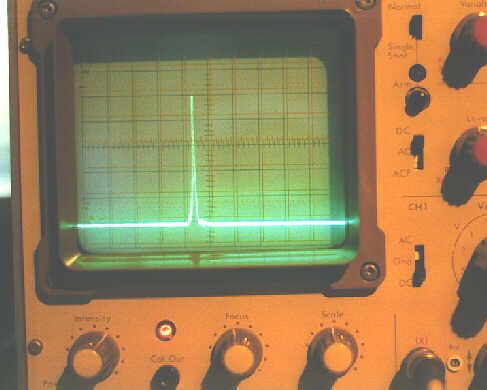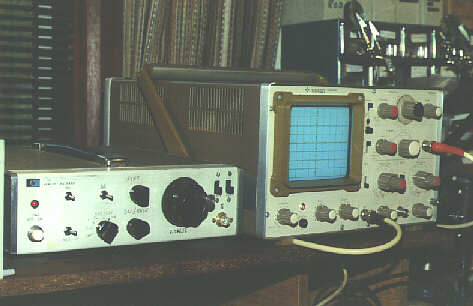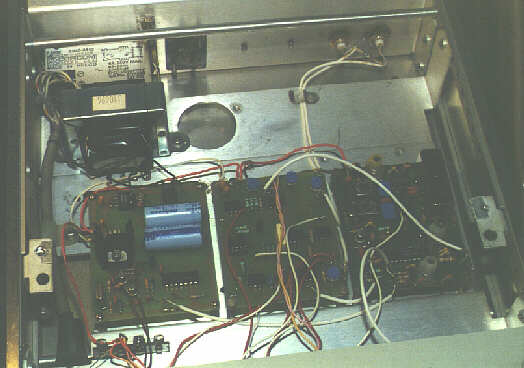 A SIMPLE SPECTRUM ANALYSER
A SIMPLE SPECTRUM ANALYSER A SIMPLE SPECTRUM ANALYSER
A SIMPLE SPECTRUM ANALYSERThe author, Roger Blackwell, G4PMK, is a well-known microwave operator and writer. He is the UK representative for Dubus. It is worth visiting his website by the way!
Since the original article, Roger has developed a more sophisticated version but we haven't yet persuaded him to write it up!

I did not construct the adapter shown on the left in this photo.
It was made by the late Alan Grayson, G4FXW and I was offered the chance
of buying it when Alan disposed of some equipment a few years ago. I have
been quite surprised just how useful this simple unit can be! While it
is limited in range and is an obvious compromise, it still allows some
very useful measurements and adjustments to be made. Alan built it into
a surpus Hewlett Packard case by the way, so it has at least some prestige
value!
 The SSA covers the range 0 to 100MHz. It is basically a double conversion
receiver in which the input frequency, 0-100MHz is mixed with a varicap-tuned
local oscillator, tuning the range 145-245MHz, thus producing an IF of
145MHz. This is then downconverted to 10.7MHz. After filtering, this signal
enters a logarithmic IF strip whose logarithmic output (basically the S-meter
output of an MC3357 receiver chip) is fed to the Y plates of an oscilloscope.
The X plates receive the output from the swept local oscillator. A crystal-controlled
frequency marker generates useful calibration signals at 10MHz and/or 1MHz
intervals.
The SSA covers the range 0 to 100MHz. It is basically a double conversion
receiver in which the input frequency, 0-100MHz is mixed with a varicap-tuned
local oscillator, tuning the range 145-245MHz, thus producing an IF of
145MHz. This is then downconverted to 10.7MHz. After filtering, this signal
enters a logarithmic IF strip whose logarithmic output (basically the S-meter
output of an MC3357 receiver chip) is fed to the Y plates of an oscilloscope.
The X plates receive the output from the swept local oscillator. A crystal-controlled
frequency marker generates useful calibration signals at 10MHz and/or 1MHz
intervals.
In this photo the three pcb boards are:
Left: Marker Generator and Power Supply Centre:
Video/sweep pcb Right: RF section
The BNC sockets at the rear are the X and Y outputs to the oscilloscope.
Almost any oscilloscope can be used, provided it has 100mV/cm sensitivity and an external input to the X amplifier.
I use mixer downconverters to "see" the various microwave bands in which I have an interest. A redundant 10GHz Gunn diode mixer receiver downconverts 10GHz to a centre IF of 50MHz and I also have a 24GHz Gunn module doing a similar thing for that band. While you don't get much range along the bottom of the display you do at least have signals to look at for filter adjustment, etc.
At HF the SSA is most useful of course as no downconverters are required. It's easy to check out HF transceivers and the like.
The noise floor of the SSA is around -85dBm. It requires an input of no greater than -20dBm (or +10dBm via the stepped attenuator provided).
A full kit of parts ( with all necessary paperwork) is available from J.A.B Electronics:
BADGER BOARDS, J.A.B ELECTRONIC COMPONENTS,
P.O. Box 5774,
Great Barr,
BIRMINGHAM, B44 8PJ,
ENGLAND
Telephone: (UK) 0121 682 7045
Fax: (UK) 0121 681 1329
![]() RETURN TO SIMPLE TEST GEAR INTRODUCTION
RETURN TO SIMPLE TEST GEAR INTRODUCTION